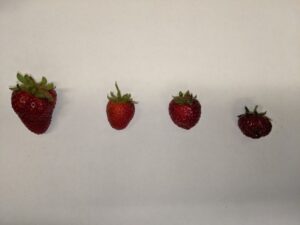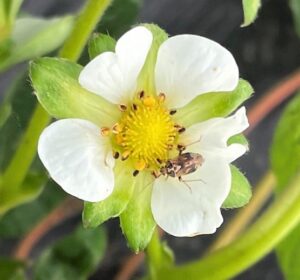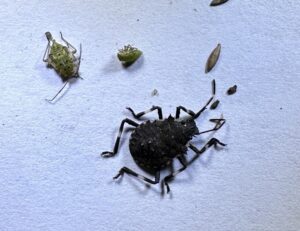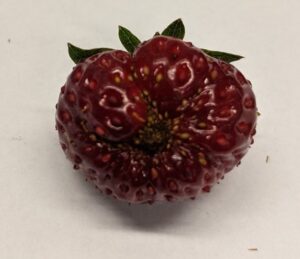Lygus is a genus of insects within the family Miridae (Order: Hemiptera, piercing-sucking true bugs) that often feed on common horticultural crops. These small insects have rather large eyes, heavily patterned, neutrally colored wings, and long spindly antennae. The diet of Lygus bugs, as they are colloquially called, is incredibly diverse ranging from cotton and alfalfa to strawberry and tomato. Lygus lineolaris (Fig. 1), or the Tarnished Plant Bug, is one of the most prominent species distributed throughout the U.S.
Lygus bugs are paurometabolous insects, meaning they undergo three life stages: egg, nymph, and adult. Adult females lay their eggs in the early spring, often on the stem, leaves. or blooms of the host plant. On average, it takes about 2 weeks for nymphs to emerge from eggs, however, this is highly dependent on species as well as temperature. Nymphs are often easy to spot, sporting ribbed oval bodies and black-spotted backs, often green or red-brown in color (Fig. 2). Nymphs occupy the same niche as adults, consuming the same type and amount of plant material as their counterparts. Lygus bugs reach full maturity around mid-summer, and overwinter in leaf litter during the colder months, emerging in early Spring to lay eggs.
Lygus bugs can cause impressive damage to a wide range of host plants, inserting their stylet-like mouthparts into no specific area—they can consume anything from leaf to flower to seed plant tissue—leading to their status as a pest in many crops. One of the most prominent commodities Lygus bugs can be found on is strawberries (Fig. 3). Often feeding on buds and seeds, causing strawberry fruits to be deformed (often called cat-facing), reducing yield (Figs. 4-5).

Figure 5: Comparison of regular strawberries (left hand side) to “cat-faced” strawberry (far right) (Photo by Eric Burkness)
To control Lygus bugs, there are several options for biological control. Lygus bugs find enemies in parasitoid wasps, tiny insects that target their eggs. These are not available commercially but can be found alongside the pest, making them a non-commercial form of biological control. More commonly, it is recommended to use lady beetles, green lacewings or damsel bugs, all of which are commercially available. These predatory insects feed on all stages of Lygus bugs and many different species, making them a good investment for management when it comes to high pest populations. For chemical control options refer to the Midwest Vegetable Production Guide or the Midwest Fruit Pest Management Guide, depending on your crop. Always read the label of any product you apply.



